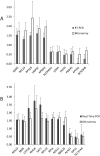Comparative functional genomics of adaptation to muscular disuse in hibernating mammals
- PMID: 25314618
- PMCID: PMC4245363
- DOI: 10.1111/mec.12963
Comparative functional genomics of adaptation to muscular disuse in hibernating mammals
Abstract
Hibernation is an energy-saving adaptation that involves a profound suppression of physical activity that can continue for 6-8 months in highly seasonal environments. While immobility and disuse generate muscle loss in most mammalian species, in contrast, hibernating bears and ground squirrels demonstrate limited muscle atrophy over the prolonged periods of physical inactivity during winter, suggesting that hibernating mammals have adaptive mechanisms to prevent disuse muscle atrophy. To identify common transcriptional programmes that underlie molecular mechanisms preventing muscle loss, we conducted a large-scale gene expression screen in hind limb muscles comparing hibernating and summer-active black bears and arctic ground squirrels using custom 9600 probe cDNA microarrays. A molecular pathway analysis showed an elevated proportion of overexpressed genes involved in all stages of protein biosynthesis and ribosome biogenesis in muscle of both species during torpor of hibernation that suggests induction of translation at different hibernation states. The induction of protein biosynthesis probably contributes to attenuation of disuse muscle atrophy through the prolonged periods of immobility of hibernation. The lack of directional changes in genes of protein catabolic pathways does not support the importance of metabolic suppression for preserving muscle mass during winter. Coordinated reduction in multiple genes involved in oxidation-reduction and glucose metabolism detected in both species is consistent with metabolic suppression and lower energy demand in skeletal muscle during inactivity of hibernation.
Keywords: arctic ground squirrel; black bear; functional genomics; gene expression; hibernation; protein biosynthesis.
© 2014 John Wiley & Sons Ltd.
Figures



References
-
- Andres-Mateos E, Brinkmeier H, Burks TN, Mejias R, Files DC, Steinberger M, Soleimani A, Marx R, Simmers JL, Lin B, Finanger Hedderick E, Marr TG, Lin BM, Hourdé C, Leinwand LA, Kuhl D, Föller M, Vogelsang S, Hernandez-Diaz I, Vaughan DK, Alvarez de la Rosa D, Lang F, Cohn RD. Activation of serum/glucocorticoid-induced kinase 1 (SGK1) is important to maintain skeletal muscle homeostasis and prevent atrophy. EMBO Molecular Medicine. 2013;5:80–91. - PMC - PubMed
-
- Barboza PS, Farley SD, Robbins CT. Whole-body urea cycling and protein turnover during hyperphagia and dormancy in growing bears (Ursus americanus and U. arctos) Canadian Journal of Zoology. 1997;75:2129–2136.
-
- Barnes BM. Freeze avoidance in a mammal - body temperatures below 0-degrees-c in an arctic hibernator. Science. 1989;244:1593–1595. - PubMed
-
- Bolstad BM, Irizarry RA, Astrand M, Speed TP. A comparison of normalization methods for high density oligonucleotide array data based on variance and bias. Bioinformatics. 2003;19:185–193. - PubMed
Publication types
MeSH terms
Associated data
- Actions
- Actions
Grants and funding
LinkOut - more resources
Full Text Sources
Other Literature Sources
Molecular Biology Databases

